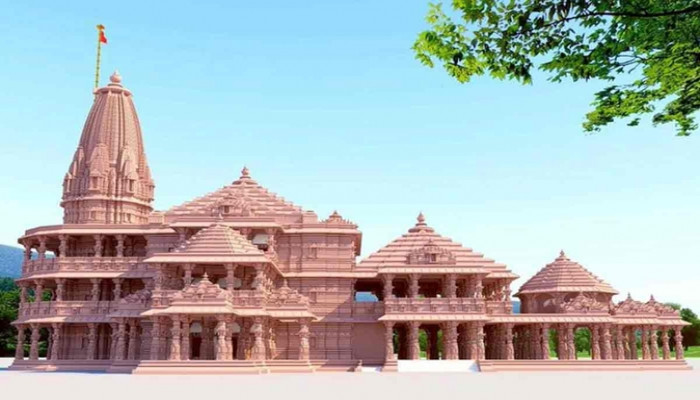Ayodhya Shri Ram Mandir A Reality Now
- In Current Affairs
- 10:49 AM, Jan 22, 2024
- Rudra Dubey
On the Anala Samvatsar Vikram Samvat 2080, Shaka Samvat 1945 (22nd January 2024) which is Dwadashi of Shukla Paksha, in Abhijit Muhurta when it will be Indra Yoga, the moon will be in the Mars-ruled Mrigashira nakshatra embodied with Soma as its deity, an epic event, that is most significant for this yuga, and most beloved to whole Bhartvarsh is happening. A significant event is itched in in history with the auspicious Ram Mandir Pran Pratishtha this date unravels a sacred sense with the birth number and destiny number 4, which has been ascribed to revolutionary changes.
Ram Temple in Ayodhya holds great significance for many Hindus and is seen as a symbol of the renaissance of Sanatan Dharma, which is a term used to describe the eternal and universal principles of Hinduism. The temple's construction is seen as a revival of Hindu pride and a reaffirmation of Hinduism's importance in Indian culture and society. Additionally, the Ram Temple is seen as a symbol of the triumph of Sanatana Dharma where Shri Ram Lalla was born and the temple was demolished in 1528 by Mir Baqi, general of Babur, who later built a mosque, named Babri masjid, over temples ruins. Historians believe that the Babri Masjid was built to suppress Hindus by the Mughals and therefore, rebuilding of Shri Ram Mandir and Pran Pratishtha of Vigrah represents the victory of Hindu resilience.
Shri Ram is the Epitome of Sanatan Dharma
Shri Ram and Veda have a significant connection in Hinduism. The Vedas are ancient Hindu scriptures that contain revelations of the gods, and Shri Ram is considered an embodiment of the Supreme God. The Vedas contain hymns and prayers that praise Shri Ram as the ultimate reality and the source of all creation. Additionally, the story of Shri Ram is deeply rooted in the Vedic tradition, and his life and teachings are seen as a reflection of the Vedic values of duty, righteousness, and compassion. Many Hindus believe that Shri Ram's life and teachings embody the essence of the Vedas and that he is the embodiment of the Vedic ideal of a perfect human being. Shri Ram and Vedanta have a deep connection in Hinduism.
Vedanta is one of the six orthodox schools of Hinduism, and it is based on the teachings of the Upanishads, which are part of the Vedic scriptures. Shri Ram, as an avatar (incarnation) of Bhagwan Vishnu, is considered an embodiment of the ultimate reality and the absolute truth that Vedanta philosophy talks about. Vedanta teaches that the ultimate reality is Brahman, and that the individual self (jiva) and Brahman are ultimately one. Shri Ram's life and teachings, as described in the Ramayana and other Hindu scriptures, are seen as a manifestation of this ultimate reality and a reflection of the Vedanta philosophy. In addition, Shri Ram's teachings on duties (swadharma), self-control (self-discipline), and detachment (vairagya) align with the key principles of Vedanta, part of the Tattriya Upanishad. His life demonstrates the ideal of a self-realized individual who has transcended the limitations of the ego and attained spiritual liberation (moksha). Thus, Shri Ram and Vedanta share a profound connection, with Shri Ram's life and teachings serving as a practical illustration of the philosophical concepts of Vedanta.
Shri Ram and the Upanishads have a significant connection in Hinduism. The Upanishads are ancient Hindu scriptures that explore the nature of the ultimate reality, the self, and the universe. Shri Ram, as an avatar (incarnation) of Bhagwan Vishnu, is considered an embodiment of the ultimate reality and the absolute truth that the Upanishads describe. The Upanishads contain teachings on the concept of Brahman, the ultimate reality that underlies all existence. Shri Ram's life and teachings are seen as a manifestation of this Brahman, and his actions and words are considered a reflection of the Upanishadic wisdom. There are several Vedic shlokas (hymns) that connect with Shri Ram:
- Rigveda 1.164.34: This shloka describes Shri Ram as the supreme God, who is born in the city of Ayodhya and is the embodiment of wisdom and strength.
- Yajurveda 3.65: This shloka praises Shri Ram as the protector of the universe and the remover of all obstacles.
- Atharvaveda 10.2.30: This shloka describes Shri Ram as the one who is beyond the three gunas (qualities) of the material world and is the ultimate reality.
These Vedic shlokas highlight Shri Ram's divine nature and his role as a protector and guide for humanity. They also emphasize his connection to the Supreme Being and his role in maintaining the order of the universe. Specifically, the Upanishads like the Rigveda, Yajurveda, and Atharvaveda contain hymns and prayers that praise Shri Ram as the ultimate reality, the creator, and the sustainer of the universe.
There are several Upanishadic shlokas that connect with Shri Ram:
- Mundaka Upanishad 3.1.3: This shloka describes Shri Ram as the embodiment of Brahman, the ultimate reality, and states that those who know him as such attain liberation.
- Taittiriya Upanishad 3.1.1: This shloka praises Shri Ram as the supreme self, the God of all, and the creator of the universe.
- Shvetashvatara Upanishad 3.2.1: This shloka describes Shri Ram as the one who is beyond the gunas (qualities) and is the ultimate reality, and states that those who worship him attain immortality.
These Upanishadic shlokas highlight Shri Ram's divine nature and his connection to the ultimate reality, Brahman. They also emphasize his role as a guide and protector for those who seek spiritual liberation.
There are several Bhagavad Gita shlokas that connect with Shri Ram:
- Bhagavad Gita 10.21: This shloka describes Shri Ram as the embodiment of divine glory and states that those who worship him with devotion attain him.
- Bhagavad Gita 10.35: This shloka describes Shri Ram as the one who is beyond the three gunas (qualities) and is the ultimate reality, and states that those who know him as such attain liberation.
- Bhagavad Gita 11.12: This shloka describes Shri Ram as the supreme God and states that those who surrender to him attain eternal peace.
These Bhagavad Gita shlokas highlight Shri Ram's divine nature and his connection to the ultimate reality, Brahman. They also emphasize his role as a guide and protector for those who seek spiritual liberation.
Shri Ram is the Supreme Being, Creator and Absolvers of the Universe
Shri Ram and Shaivism have a significant connection. Shaivism is a tradition of Hinduism that emphasizes the worship of Shiva as the ultimate reality. Shri Ram, as an avatar (incarnation) of Vishnu, is also considered to be a manifestation of the ultimate reality. In Shaivism, Shri Ram is often seen as an embodiment of Shiva's power and wisdom. The two are considered to be aspects of the same ultimate reality, with Shiva representing the transformative and destructive power of the universe, and Shri Ram representing the preservative and protective power. Additionally, Shri Ram's life and teachings are often seen as reflecting Shaivite ideals, such as the importance of self-control, devotion, and the pursuit of spiritual liberation. Some Shaivite texts, such as the Shiva Purana, also describe Shri Ram as an incarnation of Shiva, highlighting the connection between the two. Overall, while Shri Ram is typically associated with Vaishnavism, his connection to Shaivism highlights the shared underlying philosophy and the complementary nature of these two traditions within Hinduism.
Shri Ram's connection to the universe and the philosophy of Shiva can be understood through the concept of "advaita" or non-duality. Advaita Vedanta, a school of thought founded by Adi Shankara, posits that the ultimate reality is a singular, unified consciousness that underlies all existence. This consciousness is beyond the limitations of space, time, and causality. Shiva, as the ultimate reality, represents this unified consciousness. Ram, as an avatar of Vishnu, is also seen as a manifestation of this same consciousness.
In this sense, Ram and Shiva are ultimately one and the same, representing the same ultimate reality. The philosophy of Shiva, as reflected in the Shiva Sutras and other Shaivite texts, emphasizes the importance of recognizing and realizing this ultimate reality. This involves transcending the limitations of the individual ego and recognizing one's true nature as a part of the universal consciousness.
Ram's life and teachings, as reflected in the Ramayana and other texts, also emphasize the importance of self-control, devotion, and the pursuit of spiritual liberation. These teachings can be seen as a manifestation of the same philosophical principles that underlie Shaivism. In summary, Ram and Shiva are both seen as manifestations of the same ultimate reality, representing the unified consciousness that underlies all existence. Their connection highlights the shared philosophical principles of advaita and the non-dual nature of reality.
The concept of Shri Ram in the multiverse is a fascinating area of exploration. Hinduism considers Shri Ram an avatar of Vishnu, and his story is deeply connected to the idea of the multiverse. One interpretation is that Ram's journey and experiences in the Ramayana can be seen as a reflection of the multiverse concept. His battles with demons and his interactions with various beings in different realms can be viewed as encounters with alternate realities or parallel universes. Furthermore, some Hindu scriptures like the Puranas describe the existence of multiple universes or lokas, which are inhabited by various beings and deities.
Ram's story can be seen as a bridge that connects these different lokas or universes, highlighting the interconnectedness of the multiverse. However, it's important to note that the concept of the multiverse is a modern scientific idea that has evolved through advancements in physics and cosmology. While Hindu Puranas and scriptures may contain hints or allegories related to the multiverse, they shouldn't be taken as scientific explanations. Overall, exploring the connection between Shri Ram and the multiverse offers a rich and thought-provoking journey through the realms of mythology, philosophy, and science!
Shri Ram Janmbhumi and Shri Ram Temple
The original Shri Ram Temple in Ayodhya is believed to have been built by King Vikramaditya around 500 BC. Ayodhya is, believed by Hindus to be the kingdom of Shri Ram. In 1528, a masjid was built demolishing the temple to assert Mughal dominance over the local Hindu population and to showcase the might of Islam. The presence of a pre-existing temple was confirmed by the 2003 Archaeological Survey of India (ASI) excavations at the Babri Mosque site in Ayodhya. The major findings included-
- Remains of a temple's foundation
- Pillar bases and sculptured fragments, a stone inscription dated to the 12th century CE
The ASI's findings played a crucial role in the Supreme Court's 2019 verdict which unanimously ruled in the favour of handing over the land to the Shri Ram Temple Trust.
The Ram Janmabhoomi movement has a long history, with disputes dating back to the 18th century. British records from 1858 mention a dispute over the ownership of the site, and both Hindus and Muslims have been attempting to stake their claim to the land ever since. During the British Raj, Hindus took legal action for Ram Janmabhoomi in 1885, filing a suit for the right to build a temple on the site. However, the court ruled in favour of the Muslim defendants, citing the mosque's longstanding existence and denying Hindus' claims. Subsequently, the British colonial government erected gates around the Ram Janmabhumi site and locked it prohibiting Hindus from worshipping there.
After independence in 1950 Prime minister of India, Jawaharlal Nehru ordered the removal of moorthis. KK Nayar, the District Collector of Faizabad, refused to carry out the order, citing potential danger to life and communal unrest. The first lawsuit regarding Ram Janmabhoomi in independent India was filed in 1950 by Gopal Singh Visharad, seeking an injunction to prevent the removal of idols from the disputed site. After a long legal fight, in 1986, the district judge ordered reopening of the locks from the Ram Janmabhumi site, and allowed Hindus to worship.
However, the access to the area was restricted following the acquisition of the area in under the Ayodhya Act in 1993 following the demolition of Babri Masjid. The Ram Janmabhumi issue faced more trouble after the enactment of The Places of Worship (Special Provisions) Act, 1991 to prohibit the conversion of any place of worship from its existing religious status as of August 15, 1947, and to prevent reclaim of temples that faced destruction and demolition by invaders.
Shri Ram Mandir in Ayodhya, a reality now
Shri Ram Temple was designed by chief architects, Chandrakant Sompura Nikhil Sompura and Ashish Sompura is built in Indian Nagar Style housing the murthi sculpted by Arun Yogi Raj.
The Temple has 3 storeys standing on 392 pillars. The garbh grih (Sanctum Sactorum) will be adorned with Shri Ram Lalla’s idols made up of 60 million years old Shaligram rocks.
Shree Ram, as an avatar of Vishnu, represents the divine energy that connects the individual self (Atman) to the ultimate reality (Brahman). In the Advaita Vedanta tradition, the individual self (Atman) and the ultimate reality (Brahman) are seen as ultimately identical. The goal of spiritual practice is to realize this identity, achieving self-realization or enlightenment. Shri Ram, as a manifestation of Vishnu, embodies this unity and serves as a bridge between the individual and the ultimate reality. In other words, Shri Ram represents the divine potential within each individual, guiding them towards self-realization and unity with Brahman.
Image source: Organiser







Comments